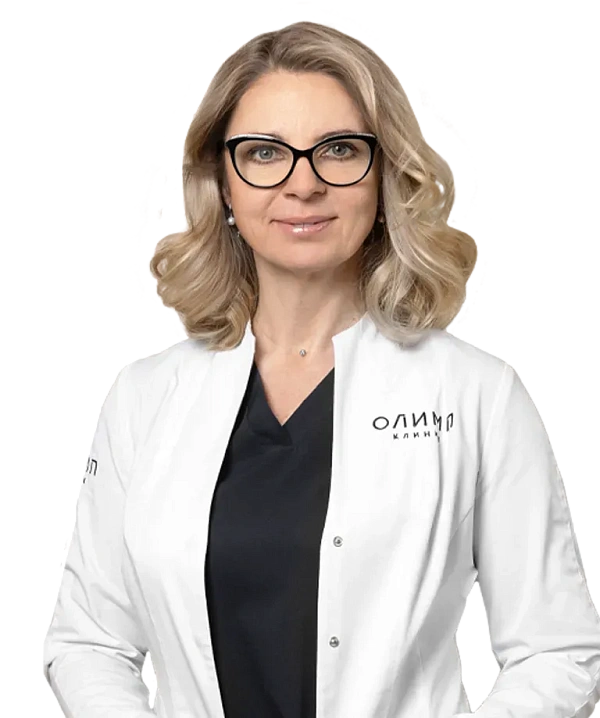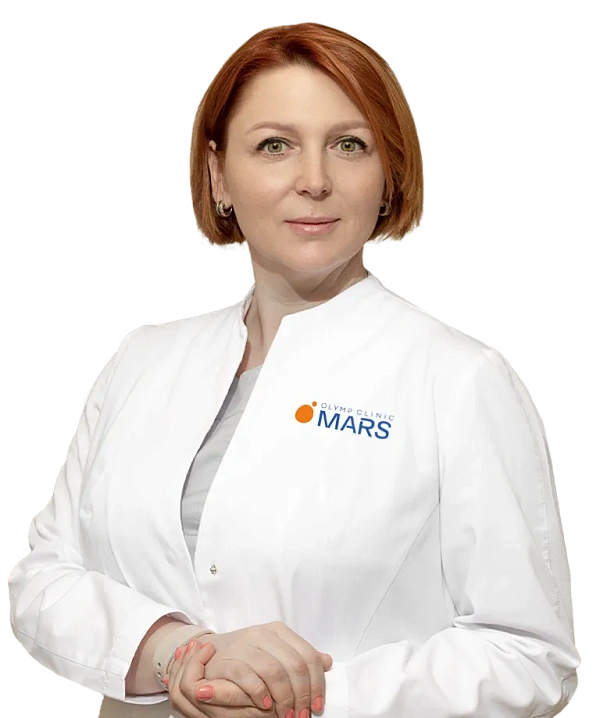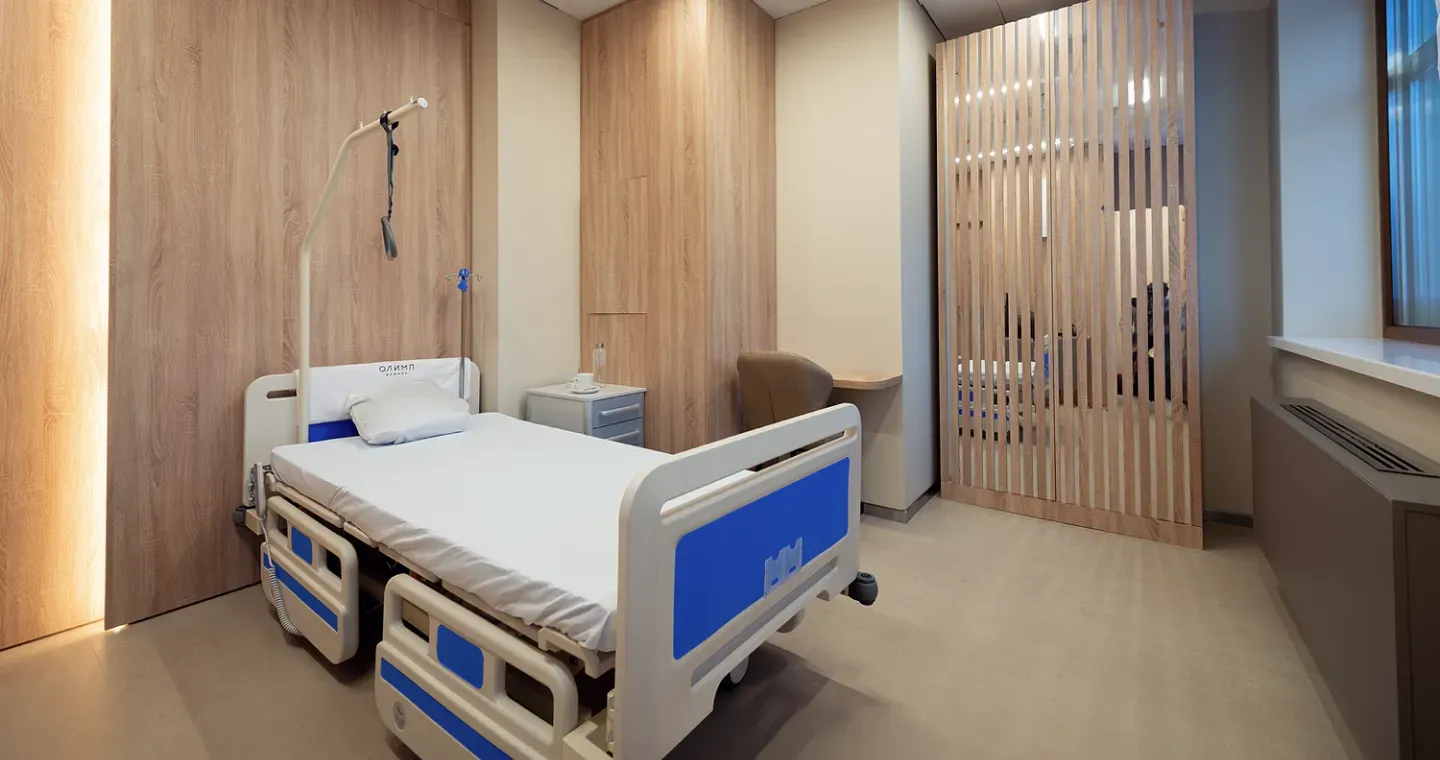Treatment of stress urinary incontinence
Urination in women is a common complaint, with age the number of cases increases. This problem is radically solved by minimally invasive surgical TVT-mixing.

Minimally invasive functional gynecology at Olympus Clinic can significantly reduce the time of surgical intervention, eliminate the cause of pathology, reduce the risk of tissue damage and speed up the patient’s rehabilitation process.
Benefits
Short-term recovery period
Patients quickly return to normal life, often the very next day after surgery.
Minimal invasiveness
The procedure requires only small incisions, which reduces the risk of complications and shortens recovery time.
High efficiency
Most women report significant improvement or complete disappearance of urinary incontinence symptoms after the procedure.
Long-lasting result
The effectiveness of the TVT intervention persists for many years after surgery.
Consultation
During the initial consultation, the gynecologist-surgeon conducts a clinical examination of the patient. A comprehensive diagnosis is prescribed: general urine analysis, serological tests (back-sowing, urine culture for microflora), uroflowmetry, cystoscopy, ultrasound of the bladder, MRI of the lumbar spine. If surgical intervention is necessary, preparations for elective surgery begin.

Operation
Surgical treatment of urinary incontinence using the TVT-O method is minimally invasive, therefore it takes about 15 minutes. TVT intervention is performed under general or spinal anesthesia. During the procedure, a special tape is inserted through small incisions in the vaginal area and above the pubis, which supports the urethra in the correct position, preventing involuntary urine output. Discharge usually takes place 1-2 days after surgery.
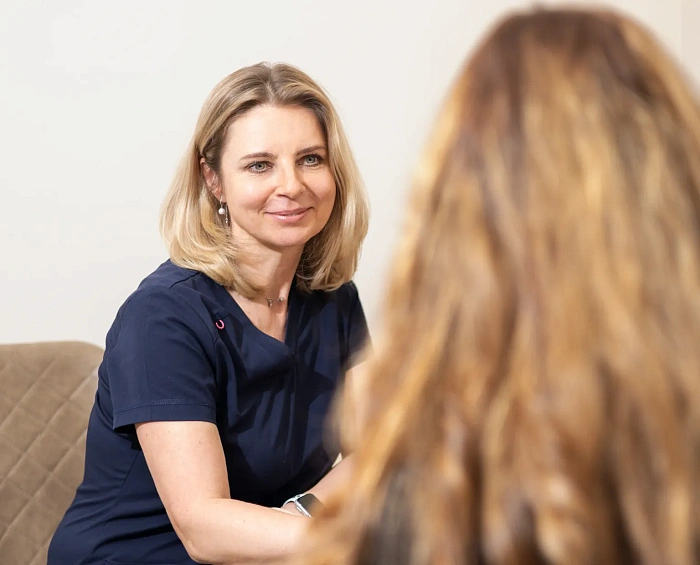
Rehabilitation after treatment of urinary incontinence
After the operation, prescriptions and recommendations from the attending gynecologist are issued. A woman can return to her normal lifestyle immediately after surgery. There is practically no pain syndrome, you can go back to work literally a couple of days after discharge. Mandatory conditions for successful recovery after sling surgery are sexual rest and limitation of physical activity for 1.5-2 months.
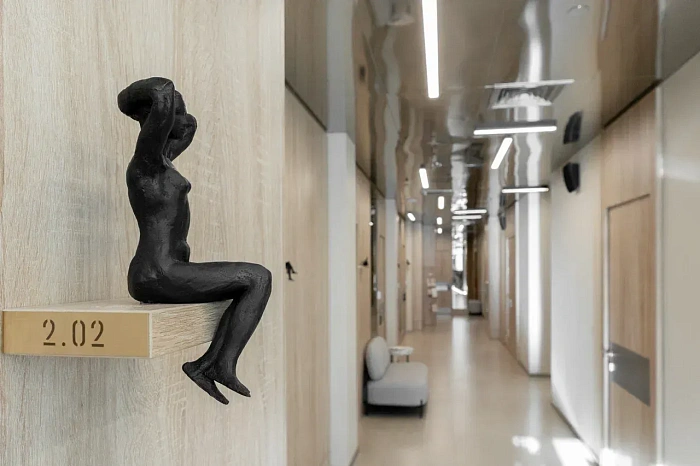
Frequently Asked Questions
What treatment methods does Olympus Clinic MARS offer?
What operations are performed to treat urinary incontinence?
How long will the effect last?
Didn't find an answer to your question?
You can describe your problem in detail and ask a question to the doctor. He will answer you and help you find a solution
Specialists
Find a SpecialistDoctor of the highest category, surgical obstetrician-gynaecologist specialising in anti-age and bioregenerative medicine, oncologist
Candidate of Medical Sciences. Gynecologist-obstetrician. Head of the gynecology department.
Indications and contraindications
Indications
Acquired stress incontinence
Involuntary urine allocation caused by stress
History of childbirth with complications
Childbirth accompanied by pelvic floor injuries may increase the risk of stress urinary incontinence.
Inefficiency of conservative therapy
The absence of a long-term positive effect from the use of medications, physiotherapy and exercises to strengthen the pelvic floor muscles.
Menopause
Changes in hormone levels and loss of tissue elasticity associated with menopause can exacerbate the symptoms of urinary incontinence.
Expected effect
Relief from physical discomfort
From 30 to 50% of women who give birth face the problem of urinary incontinence. This number increases to 60% by menopause.
Returning the functionality of the intimate area
Stress incontinence causes two interrelated processes: damage to the ligaments that support the uterus, bladder, urethra, and weakness of the pelvic floor muscles. Moreover, a decrease in the tone of the vaginal muscles and pelvic diaphragm leads to prolapse of the walls of the vagina and uterus.
Elimination of symptoms
The procedure helps to significantly reduce or completely get rid of involuntary urine output.
Improving the quality of life
Improvement of emotional state and social activity by eliminating discomfort and inconvenience.
Similar referral activities
Removal of tumors in the intimate area
A procedure aimed at eliminating benign growths such as papillomas, warts, cysts and genital warts.
Reproductive surgery
Surgical treatment and simultaneous accurate diagnosis of female infertility factors: adhesions, endometriosis, congenital malformations of the genital organs, obstruction of the fallopian tubes, intrauterine pathology (septum and synechia), polycystic ovary syndrome.
Colposcopy procedure
A procedure in which a doctor can use a colposcope to examine the vagina, cervix and vulva, examine the mucous membrane in detail and identify abnormal changes that may be a sign of diseases.
Cervical plastic surgery
Cervical plastic surgery (tracheloplasty) is a surgical restoration of the anatomical structure and function of the cervix, which helps to maintain the health of the reproductive system.
Treatment of vulvar diseases
Vulvar diseases, including chronic fissures, sclerotrophic lichen and other dermatological conditions. We offer modern and effective treatment methods aimed at reducing symptoms and restoring the normal condition of the vulva skin.
Correction of menopause problems
The onset of menopause is often accompanied by a number of physical and mental manifestations unpleasant for a woman. The gynecologist will choose therapy, which can relieve or completely eliminate the symptoms.
News & Media
All news and mediaThe III All-Russian Progress Conference "Aesthetic Gynecology and Perineology: balance of beauty and functionality" was held in Moscow
The event lasted from 24 to 26 May, and the theme was Aesthetic gynecology and perineology: the balance of beauty and functionality.
What to do with urinary incontinence after childbirth?
Find answers to your questions and feel more confident.
What is important for every woman to know about the cervix?
Everything you need to know about the cervix is now collected in one article on the website of the "Daughter-mother".
Why should your mother visit a gynecologist?
We all understand why girls should visit a gynecologist. This specialist will help solve various problems related to women's health — from pregnancy management to the prevention of sexually transmitted diseases. However, over time, when women get out of reproductive age, they begin to contact a gynecologist less and less often, mistakenly believing that they no longer need his help. But a gynecologist is not only about reproductive health, he can help in solving many other issues related to the female body. So what questions can your mother ask a gynecologist about?
How to strengthen the pelvic floor muscles?
Intimate problems are often hushed up, it is awkward to talk about them even with a doctor. However, if the issue concerns the health of the pelvic floor, it is better not to waste time and immediately consult a doctor. After all, problems with this area can lead to very unpleasant consequences.
Uterine bleeding — is it worth sounding the alarm?
Abnormal uterine bleeding is when the bleeding goes beyond the normal menstrual cycle. The discharge may be more abundant or last longer. The "normal" menstrual cycle is different for everyone. But menstruation shouldn't be a problem for you.: a serious condition that prevents you from engaging in any activity, forces you to skip work or study. In the article we will tell you how to distinguish abnormal uterine bleeding.
Stress-free menopause: how hormone therapy helps women
With age, women experience a natural decrease in reproductive function, known as menopause. This process takes a long time and is accompanied by changes in the physical and emotional state, hormonal restructuring and complete cessation of menstruation. On average, menopause (the so-called last menstruation in a woman's life) occurs at the age of 45-55 years, but its precursors may appear earlier, and the process of "restructuring" the body can last for several years. A decrease in the level of female sex hormones leads to unpleasant symptoms that not only worsen the quality of life, but can also contribute to the development of serious diseases. Although menopause is not a disease and does not require treatment, there are methods to improve well-being and prevent complications. One of these methods is menopausal hormone therapy (MGT). The decision on the need and time of MGT is made by a gynecologist. To understand whether such therapy is necessary for all women, it is important to understand the nature and characteristics of menopause.
How to reach
How to get
From the Belorusskaya metro station of the Zamoskvoretskaya line - exit 4 After exiting the subway, walk through the pedestrian tunnel and climb the stairs. Move towards the railway tracks, go down the stairs immediately after them and walk along the house, then turn right onto 1st Yamskoye Pole Street. At the turn to 3rd Yamsky Pole Street, cross the road at the pedestrian crossing and continue along 1st Yamsky Field Street, after a few buildings on the left you will see Olympus Clinic MARS.
Travel time
9 minutes
Landmark
Olympus Clinic MARS sign
How to get
From the Belorusskaya metro station of the Ring line - exit 2. After exiting the subway, turn left and walk to the pedestrian crossing. Cross the road through two pedestrian crossings and move along the Tverskoy overpass. Go down the stairs immediately after the railway tracks, walk along the house, then turn right onto 1st Yamskoye Pole Street. At the turn to 3rd Yamsky Pole Street, cross the road at the pedestrian crossing and continue along 1st Yamsky Field Street, after a few buildings on the left you will see Olympus Clinic MARS
Travel time
11 minutes
Landmark
Olympus Clinic MARS sign
From the metro station "Tsvetnoy Bulvar"
1 exit to the city, then left to the Garden Ring, at the crossing to the right, crossing the boulevard, one more crossing and at the traffic light to the left. The Olymp Clinic building is located overlooking the Garden Ring to the right of the crossing. Travel time is approximately 9 minutes. Landmark - sign Olymp Clini
From the metro station "Sukharevskaya"
Exit 3 from the metro and 640 meters straight ahead, the clinic will be on the right. Landmark - sign Olymp Clinic
Parking lot map
Exit 3 from the metro and 640 meters straight ahead, the clinic will be on the right. Landmark - sign Olymp Clinic
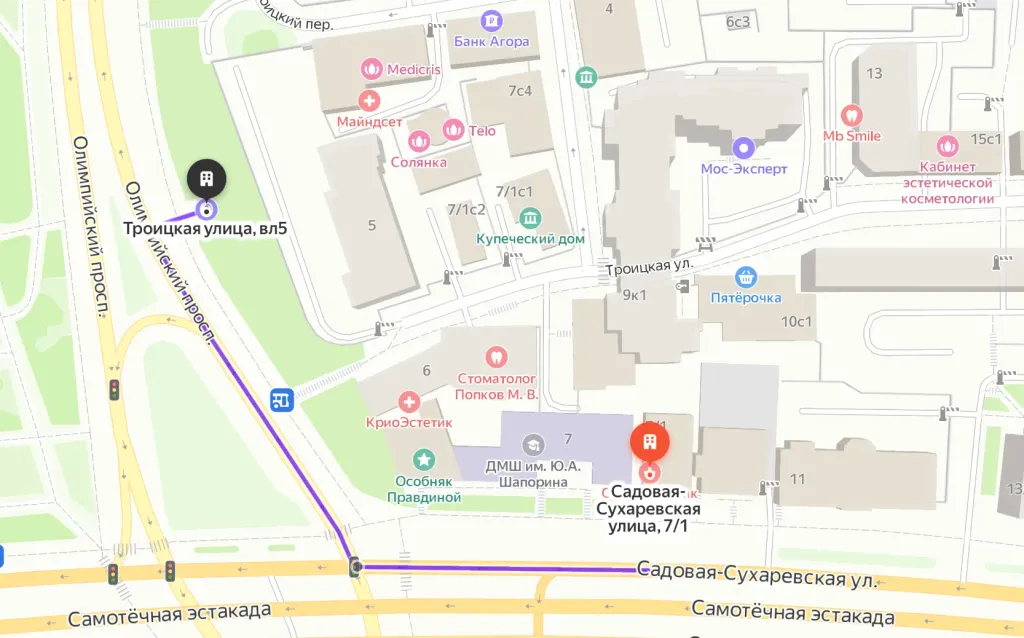
From Sokol metro station
The last car from the center: follow the signs for Exit 5. From the glass doors to the right and go to the end of the passage. Exit to the city by the steps to the left. After exiting the crossing to the street, go straight along Leningradsky Prospekt to the intersection with Chapaevsky Lane. Next, turn right (onto Chapaevsky Lane) and walk to the Triumph Palace residential complex. Entrance to the territory: through checkpoint No. 1, opposite the Vkusville store, you will need to present your passport. After passing through the checkpoint, go up the stairs to the fountain, opposite it you will see our clinic.
Travel time
10-12 minutes
From the Airport metro station
The first car from the center: follow the Exit 2-3 signs. Turn left out of the glass doors and walk to the end of the passage. After exiting the crossing to the street, go straight along Leningradsky Prospekt to the intersection with Chapaevsky Lane. Next, turn left (onto Chapaevsky Lane) and walk to the Triumph Palace residential complex. Entrance to the territory: through checkpoint No. 1, opposite the Vkusville store, you will need to present your passport. After passing through the checkpoint, go up the stairs to the fountain, opposite it you will see our clinic.
Travel time
12-15 minutes
How to get
Entry to the territory is prohibited, but there are free city parking lots around the Triumph Palace residential complex, where you can easily find a place for your car. Free parking area:

